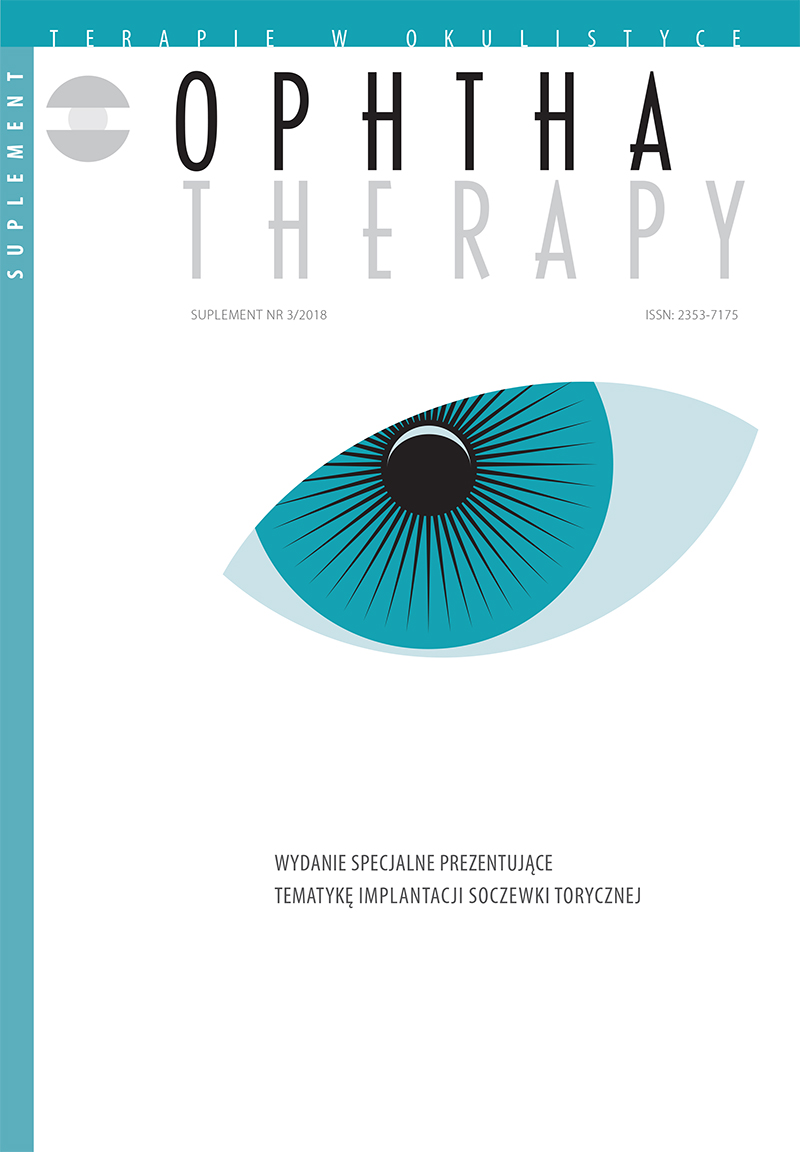Intraocular toric lenses and their application in the correction of astigmatism in cataract surgery – analysis of the refraction outcome and axial stability of the AcrySof® IQ Toric SN6ATx intraocular lens
Main Article Content
Abstract
Purpose: To evaluate distance visual acuity, objective refraction, corneal keratometry and rotational stability after cataract surgery with an implantation of monofocal AcrySof® IQ Toric SN6ATx in a 6 months follow up.
Material and methods: A total of 40 eyes of 30 patients underwent 2.2 mm coaxial cataract surgery with an implantation of AcrySof® IQ SN6ATx. Before and six months after the surgery uncorrected and best-corrected distance visual acuity, objective refraction, corneal keratometry and rotational stability of the implant were analyzed.
Results: Six months after the surgery there was statistically significant improvement of uncorrected and best-corrected distance visual acuity (p = 0.00). There was no significant change in corneal keratometry in flat and steep meridian (p = 0.45 and p = 0.12) and keratometric cylinder (p = 0.49). There was statistically significant decrease in objective refraction cylinder (p = 0.00). The mean rotation of an implanted intraocular lens axis was 3,35°. There were no intra- and post-operative complications in any of the patients.
Conclusions: AcrySof® IQ Toric SN6ATx implantation is a safe and effective method to correct corneal astigmatism during cataract surgery
Downloads
Article Details

This work is licensed under a Creative Commons Attribution-NonCommercial-NoDerivatives 4.0 International License.
Copyright: © Medical Education sp. z o.o. License allowing third parties to copy and redistribute the material in any medium or format and to remix, transform, and build upon the material, provided the original work is properly cited and states its license.
Address reprint requests to: Medical Education, Marcin Kuźma (marcin.kuzma@mededu.pl)
References
2. Höhn F, Tandogan T, Breyer DRH et al. Funktionelle Ergebnisse 1 Jahr nach Implantation einer bitorischen, trifokalen Intraokularlinse. Klin Monatsblätter Für Augenheilkd. 2015; 232(08): 957-61.
3. Gyöngyössy B, Jirak P, Schönherr U. Rotational Stability and Patient Satisfaction after Implantation of a New Toric IOL Rotational Stability and Patient Satisfaction after Implantation of a New Toric IOL. Eur J Ophthalmol. 2016; 26(4): 321-7.
4. Vale C, Menezes C, Firmino-Machado J et al. Astigmatism management in cataract surgery with Precizon® toric intraocular lens: a prospective study. Clin Ophthalmol Auckl NZ. 2016; 10: 151-9.
5. Marques EF, Ferreira TB, Simões P. Visual Performance and Rotational Stability of a Multifocal Toric Intraocular Lens. J Refract Surg. 2016; 32(7): 444-50.
6. Emesz M, Dexl AK, Krall EM et al. Randomized controlled clinical trial to evaluate different intraocular lenses for the surgical compensation of low to moderate-to-high regular corneal astigmatism during cataract surgery. J Cataract Refract Surg. 2015; 41(12): 2683-94.
7. Ng HR, Goh CH, Ngim YS et al. Evaluation of visual outcomes after toric intraocular lens implantation. Med J Malaysia. 2017; 72(6): 356-9.
8. Williams KM, Verhoeven VJM, Cumberland P et al. Prevalence of refractive error in Europe: the European Eye Epidemiology (E3) Consortium. Eur J Epidemiol. 2015; 30(4): 305-15.
9. Ferrer-Blasco T, Montés-Micó R, Peixoto-de-Matos SC et al. Prevalence of corneal astigmatism before cataract surgery. J Cataract Refract Surg. 2009; 35(1): 70-5.

